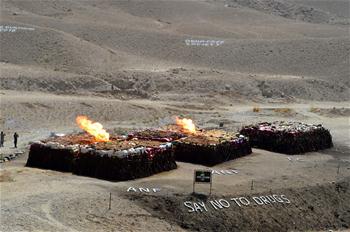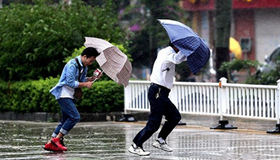by Chen Yanbei, Guo Shuang
LOS ANGELES, Oct. 20 (Xinhua) -- Yi Ni, professor of mathematics at the California Institute of Technology (Caltech), was sitting at his desk working as usual in the morning.
At 10:20 a.m. local time (1720 GMT), he ducked under his desk, covering his head with his hands. He stayed like this for two minutes, and then stood, stretched, and went back to work.
A day earlier, Ni, like most southern Californians, received an email about the Great California ShakeOut earthquake drill on Oct. 20. That morning was his practice of the Drop, Cover, and Hold On instruction when facing an earthquake.
At lunch time, Ni visited Caltech's personal preparedness fair, where he received advice on building a personal and family emergency plan, and suggestions on essential supplies he should have on hand for all members of his family.
The annual earthquake drill is organized collaboratively by U.S. federal and state government agencies, the local government, utility providers, research and academic institutions, non-profit organizations like the American Red Cross, as well as private businesses.
It not only prepares individuals for the next major earthquake, but also exercises how different organizations can work together during such an emergency.
The first such drill, known as the Great Southern California ShakeOut, took place in 2008 with 5.3 million participants. The number of participants increased each year, and eight years later, it reached over 19.5 million in the United States.
There are now 20 ShakeOut regions across the world carrying out similar drills, and more than 54.6 million global participants have already registered for 2016.
The high turnout of the ShakeOut Drill comes from Californians' anxiety over earthquakes. In late September, frequent small earthquakes at the Salton Sea, southern California, prompted scientists to increase their estimate on the chances of an imminent major earthquake on the San Andreas Fault. Many seismologists argued that one of those small earthquakes may set off a big event.
On Sept. 30, the U.S. Geological Survey (USGS) reported that the chance for an earthquake magnitude 7 or greater, within one week, could have become as high as 1 in 500.
An earthquake advisory was issued by the California Office of Emergency Services, triggering major anxiety among Californians. The small quakes later subsided, and the likelihood of an earthquake occurring returned back to the usual value, below 1 in 10,000, and the advisory period ended.
However, according to a 2015 report by the USGS, the chance of a magnitude 8 or greater earthquake hitting California in the next three decades is 7 percent. In other words, the rate of a magnitude 8.0 or greater earthquake is once per 494 years.
Last year, scientists at U.S. space agency NASA's Jet Propulsion Laboratory calculated a 99.9 percent probability for a magnitude 5 or larger earthquake to strike the greater Los Angeles area between April 1, 2015, and April 1, 2018. This result was disputed by the USGS, which put the probability at 85 percent, which is hardly more reassuring.
Earlier this month, scientists discovered a new type of earthquake. "The discovery of unusually deep seismicity sheds light on the physical mechanisms that promote earthquakes in the high temperature and pressure conditions at the top of the Earth's mantle," Lingsen Meng, a seismologist at the University of California, Los Angeles, told Xinhua.
Irrespective of new scientific discoveries, experts suggest everyone be constantly prepared for earthquakes.
"Year of a disaster is unknown, but impacts are very predictable," tweeted Lucy Jones, a seismologist at USGS. "You can't change chance of EQ (earthquake) but you can reduce the chance of damage."










